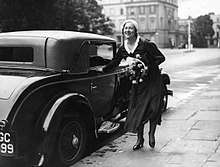Elvira Barney
Elvira Enid Barney (née Mullens; 22 January 1904 – 25 December 1936) was an English socialite and actress known professionally as Dolores Ashley. She was tried for the murder of her lover, Michael Scott Stephen, in 1932. The trial was widely reported by the British press. She was later found not guilty, but died four years later in a Paris hotel room.
Elvira Barney | |
|---|---|
 | |
| Born | Elvira Enid Mullens January 22, 1904 |
| Died | December 25, 1936 (aged 32) |
| Other names | Dolores Ashley |
| Years active | 1925–1933 |
| Movement | Bright Young Things |
| Spouse(s) | John Sterling Barney ( m. 1928–1933) |
| Partner(s) |
|
| Parents |
|
Barney was part of the Bright Young Things group of socialites and aristocrats in the 1920s.
Early life
Elvira Mullens was born on 22 January 1904, the daughter of Sir John Ashley Mullens (1869–1937), a stockbroker, and Evelyne Maude Adamson (1874–1962). Her younger sister, Avril Joy Mullens, married three times: including a short marriage to Ernest Aldrich Simpson, ex-husband of Wallis Simpson.[1][2]
In 1924, she attended Lady Benson's Drama Academy, to be taught by Constance Benson. In the same period she was engaged to Charles Patrick Graves.[1] During the 1924–25 theatre season she appeared in The Blue Kitten at the Gaiety Theatre.[1]
She met John Sterling Barney, an American singer, at a party in 1927. They were married on 2 August 1928. However, John Barney returned to America the following year.[1][2]
In 1931, she moved to 21 William Mews, Knightsbridge, London, sharing the home with Henry Mervyn Pearce. She later met Michael Scott Stephen while in Paris. He moved into the William Mews sometime prior to May 1932.[1]
Trial and aftermath

On 30 May 1932, Barney and Stephen hosted a dinner party at their home; among the guests were: Arthur Jeffress, Hugh Armigel Wade, Sylvia Coke, Denys Skeffington Smyth, Brian Howard, Anton Altmann, Irene MacBrayne, Arthur Streek, Olivia Wyndham and her then girlfriend, Ruth Baldwin—a longtime companion of Joe Carstairs, and Edward Gathorne-Hardy.[3] Barney, Stephen, and some of their guests then went to The Blue Angel, a private club on Dean Street.[4] The following morning, Stephen died of bullet wounds and Barney was arrested and charged with murder.
At trial, Barney was defended by Sir Patrick Hastings, who portrayed her as the innocent party and a victim of little value.[1][5] Wade and Jeffress gave testimony. Altmann, Howard, MacBrayne, Coke, Skeffington-Smyth, Streek, Fester, and Skeffington-Smyth also gave statements, some of which were read in court.[4]
The judge described Hasting's closing remarks as "certainly one of the finest speeches I have ever heard". Barney was found not guilty of murder and manslaughter, but she was convicted of possession of a firearm.[6] The press reported on Barney boasting of killing Stephen at a celebration party following the verdict.[5]
Barney moved to France, having been disowned by her family.[1] She was found dead in a Paris hotel room on 25 December 1936 after returning drunk the night before.[5]
Portrayals
Barney believed the profligate socialite Agatha Runcible in Evelyn Waugh's Vile Bodies was based on her. However, Runcible was a caricature of Elizabeth Ponsonby.[7]
See also
- Vile Bodies — novel by Evelyn Waugh.
References
- "Chronology". Cocktails With Elvira. Retrieved 15 January 2018.
- "A Princess for the Man who Engineered the Escape of Turkey's Last Sultan - 15 Jul 1934, Sun • Page 13". Detroit Free Press: 13. 1934. Retrieved 15 January 2018.
- Rose, Andrew (2007). Lethal witness: Sir Bernard Spilsbury honorary Pathologist. Sutton. p. 222. Retrieved 21 January 2018.
- "30th May 1932 – Parties". Cocktails With Elvira. Retrieved 15 January 2018.
- Rob Baker (15 November 2015). Beautiful Idiots and Brilliant Lunatics: A Sideways Look at Twentieth-Century London. Amberley Publishing Limited. pp. 85–. ISBN 978-1-4456-5120-0.
- Peter Cotes, "The Trial of Elvira Barney" (Celebrated Trials Series), David & Charles, 1976, Introduction pp. 20-35.
- "Bright Young People: The Lost Generation of London's Jazz Age". The Barnes & Noble Review. 2009-02-19. Retrieved 2019-07-26.